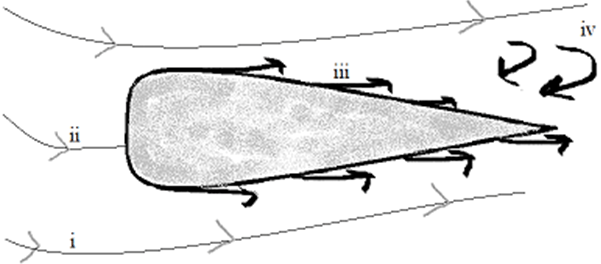This set of Aerodynamics Multiple Choice Questions & Answers (MCQs) focuses on “Viscous Flow – 2”.
1. The d’Alembert’s Paradox is concerned with ____
a) Lift arising due to pressure distribution
b) High viscous effects
c) Drag being zero for non-zero lift
d) Kutta condition not satisfied
View Answer
Explanation: The d’Alembert’s paradox arises due to the assumption of an inviscid fluid. The lift predicted with this assumption is correct but the drag comes out zero. Which is not true as pointed out by experiments or general observation.
2. The lift can be calculated accurately using the pressure distribution assuming an inviscid flow.
a) False
b) True
View Answer
Explanation: The assumption of inviscid flow does not affect the lift since the shear force component along the lift direction is negligible. Only the pressure distribution is responsible for creating lift.
3. What is responsible for creating the aerodynamic drag on the airfoil?
a) Pressure distribution
b) Friction
c) Thrust
d) Gravity
View Answer
Explanation: Viscosity causes drag on the airfoil. For an airfoil, friction is responsible for causing viscosity and hence, causes drag.
4. Select the unmatched pair.
a) Pressure distribution: lift
b) Shear stress: skin-friction drag
c) Flow separation: form drag
d) Air pressure: pressure drag
View Answer
Explanation: Lift is caused by the pressure distribution on the airfoil. The two ways drag is exerted is due to shear stress on the surface of the airfoil (skin – friction drag) and due to the flow separation (form drag, also called pressure drag).
5. The component of viscosity that creates skin-friction drag is_____

a) i
b) iii
c) ii
d) iv
View Answer
Explanation: The component that creates skin- friction drag is shear stress acting on the surface of the airfoil. This is denoted by iii in the figure.
6. Which of the following is responsible for causing form drag?

a) i
b) iv
c) ii
d) iii
View Answer
Explanation: Form drag is also known as pressure drag. The mechanism behind it is flow separation in a viscous flow which occurs near the trailing end. This is denoted by iv in the figure given.
7. The pressure drag in a fully attached flow over an airfoil is zero.
a) True
b) False
View Answer
Explanation: For the attached flow, the pressure acting at the rear end of the airfoil counteracts the pressure acting on the front edge. But once flow separation occurs, the rear pressure reduces causing a net backward pressure – pressure drag.
8. A state with flow separation and reducing lift at a high angle of attack is___
a) Climbing
b) Take off
c) Landing
d) Stall
View Answer
Explanation: Stall is characterized by a reduction in the lift at high angles of attack, i.e. when the angle of attack increases more than the critical angle of attack. The flow is no more attached and flow separation occurs.
9. Which of the following is not related to flow separation?
a) Reduction of lift
b) Increased drag
c) Adverse pressure gradients
d) Attached flow
View Answer
Explanation: The region of adverse pressure gradient near the trailing edge causes flow separation, which consequently causes lesser lift and higher drag. The flow is no more attached when flow separation occurs.
10. Flow separation causes lift to decrease with increasing angle of attack. This is inconsistent with the thin airfoil theory where the lift curve slope is 2π. This is a contradiction.
a) True
b) False
View Answer
Explanation: The thin airfoil theory assumes the angle of attack is small. Moreover, flow separation occurs for high angle of attack, for angles greater than the critical angle of attack (which is generally over 12°) where stall occurs leading to reduction of lift. So this is not a contradiction.
Sanfoundry Global Education & Learning Series – Aerodynamics.
To practice all areas of Aerodynamics, here is complete set of 1000+ Multiple Choice Questions and Answers.
If you find a mistake in question / option / answer, kindly take a screenshot and email to [email protected]
- Apply for Aerospace Engineering Internship
- Practice Aerospace Engineering MCQs
- Check Aeronautical Engineering Books
- Check Aerodynamics Books
- Practice Aeronautical Engineering MCQs
